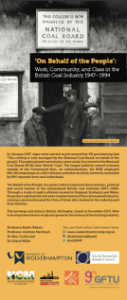By Andy Perchard and Keith Gildart
It is now 30 years since the Conservative government of John Major privatized British Coal parceling up what remained of an industry that on nationalization in 1947 had been the largest state-owned industry outside of the Soviet bloc. In 2017, two years after the closure of Britain’s sole remaining deep coal mine, Kellingley Colliery in North Yorkshire, England, we embarked on a project, ‘On Behalf of the People: Work, Community and Class in the British Coal Industry, 1947 – 1994’, to explore the history of the nationalized British coal industry with the support of the UK Arts and Humanities Research Council. We were joined on the project by Ben Curtis and Grace Millar. We planned to explore the history of nationalized coal from a fresh perspective; examining it from coalfields to the national picture, focusing on eight collieries and surrounding mining communities spread across England, Scotland and Wales.
A key motivation in this project was sharing authority with coal communities, as well as working with the remaining mining unions, to tell their history. So, as well as foraging through industry, union, government records and personal papers in archives, the team interviewed around 100 former miners and their families who shared their memories, as well as diaries, photographs and other memorabilia. We have displayed some of these on our project website. The project also partnered with the General Federation of Trade Unions and the national mining museums of England, Scotland and Wales. We anticipated from conception of the project that exploring that history and partnering with local heritage groups would be challenging in certain coalfields because of the enduring divisions left over from the bitter 1984-1985 miners’ strike; a subject we’ve explored during the course of the research and more recently in an article for Oral History on the role of social media in that process. Our research has also charted how colliery closures from the outset of nationalization but particularly with their ramping up from the late 1950s fragmented the industry and undermined public ownership with growing divisions between the coalfields and not just between the National Union of Mineworkers (NUM) and the National Coal Board (after 1987, legally changed to the British Coal Corporation), the latter and government, but also between rank and file members and union leaders and amongst managers. This was compounded by the failure of successive governments to have a coherent energy policy until the late 1960s and patchy regional policy initiatives to alleviate the impact of coalfield closures, replaced in many places by the market logic of Conservative governments after 1979 and their flawed enterprise zones. In earlier related work during the course of the project, we explored the ideological differences of managers within the coal industry and managerial trade unionism during nationalization and over colliery closures.
A key feature of the project then was to explore and share that history of nationalized coal and how those employed in the industry and their families experienced it, including the loss of the industry and campaigns against closures. One example of this was the mobilization of a broad-based community campaign which was partly responsible for saving Barony Colliery Ayrshire (Scotland), after a shaft collapse in November 1962.
The examination of the history of the nationalized industry is often seen through the prism of the 1984-1985 Miners’ Strike, meaning those relationships and divisions were very often present in the many interviews, as well as in the discussions and shared memories at coalfields events to tour the exhibition the project team created. That focus on 1984-1985 can also overshadow the legacy of closures in preceding decades, though the nature of that national strike, tearing up of accepted arbitration and conciliation measures after the defeat of the miners, sidelining of managers who opposed the NCB chairman Ian MacGregor, and the final contraction of the industry as it was prepared for privatization, and the very bitter and enduring legacies those have left, is understandably at the forefront of collective memory in the coalfields. That touring exhibition was curtailed and delayed because of the pandemic. However, we were able to hold several coalfield events, as well as at the GFTU education centre in Leicestershire.
Those events reflected the whole range of emotions associated with an industry that had once provided the lifeblood (as well as anguish and pain) of so many communities from the happiness of sharing friendships forged to palpable and residual anger of the 1984-1985 strike and the loss of those collieries.










 Figure 1. Buenaventura, Ollagüe, Chile. © Alto Cielo Archaeological Project
Figure 1. Buenaventura, Ollagüe, Chile. © Alto Cielo Archaeological Project